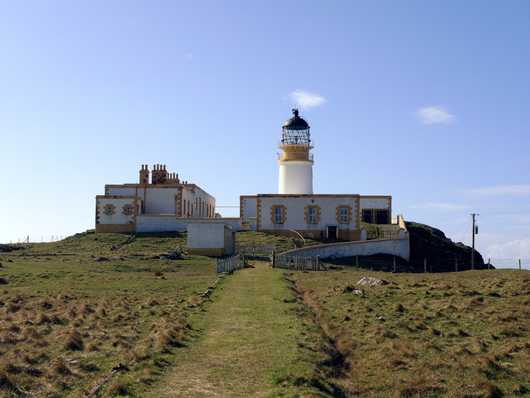Neist Point

Neist Point Lighthouse was built in 1909, atop the spectacular jagged basalt cliffs on the Isle of Skye's westernmost point, overlooking the strait known as The Little Minch, which passes between here and the Outer Hebridies.
Designed by David Alan Stevenson, it shares a number of design elements with his other lighthouses; The cylindrical tower is quite bare, with only a slight taper, and unlike those designed by his ancestors, features minimal ornamentation. The lantern room sits atop a watch-room, which would have allowed for the height of the clockwork machinery that rotated the original lens. The lantern is topped by a dome roof and rotating ventilator.
The tower is accompanied by several flat-roofed buildings, which housed the keepers, the engines, and the fog signal equipment. Completed in June 1910, the fog signal, built to a standard design, featured a red trumpet mounted on wheels atop a curved rail, allowing it to be rotated along its arc. The horn protrudes from the roof of a small hut containing the Diaphone and a self-winding clockwork mechanism that controlled its sequence and regularity.
This fairly remote lighthouse is reached by a steep winding path, which runs down the side of a sheer cliff. To combat the issue of accessibility, a cable car system was built to transport supplies up and down the cliff face; parts of this remain, although in an advanced stage of dereliction.
Another path from the lighthouse leads to a small stone-built landing stage, sheltered by the headland. This small dock, equipped with a fairly substantial Jib Crane, is where Northern Lighthouse Board tender vessels would have docked to relieve the keepers and deliver paraffin and other supplies. Alongside this path can be seen a few remnants of two pipes of different sizes, clamped to the ground - upon delivery of fuel to the landing stage, compressed air could be sent down one pipe, forcing the oil uphill through the other pipeline.
The lighthouse was automated and electrified in 1990, at which point the enormous first order Chance Brothers lens was removed and transferred to the Museum of Scottish Lighthouses in Fraserburgh. At the same time the fog signal was discontinued, and the keepers' houses were sold off. The first order lens, which had almost entirely filled the lantern room, was replaced by an almost comically small lamp in comparison, which was made up of several sealed beam units mounted in a small rotating drum, which produced the character of one White Flash every 5 seconds, visible for 16 Nautical Miles.
Around April 2018 this lamp was replaced by a stack of four LED units, reduced to two separately mounted LED lamps shortly thereafter.
The fully automatic operation of the Lighthouse is monitored remotely from the Northern Lighthouse Board headquarters in Edinburgh.
